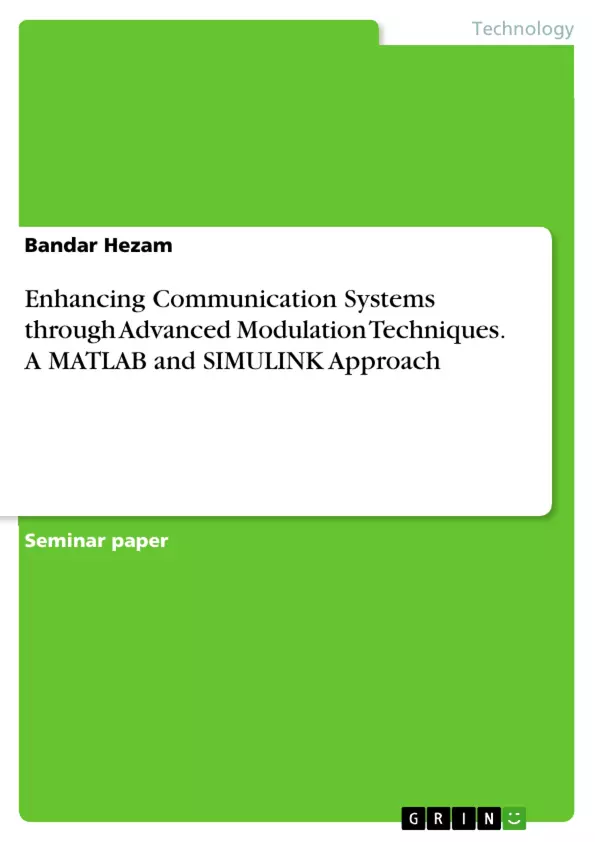This paper explores the role of modulation in telecommunications, where audio, video, image, or text information is embedded into carrier signals for efficient transmission. The study delves into three fundamental types of modulation - Amplitude Modulation (AM), Frequency Modulation (FM), and Phase Modulation (PM) - with a specific focus on the intricate details of AM. By employing MATLAB, a powerful language for technical computing, and its companion tool SIMULINK, a simulation and model-based design environment, this paper demonstrates an innovative approach to enhance communication systems. MATLAB's array-based computation and toolboxes for signal processing synergize seamlessly with SIMULINK's graphical programming capabilities, offering a comprehensive solution for modeling, simulating, and analyzing dynamic systems. The integration of these technologies not only facilitates the implementation of advanced modulation techniques but also enables systematic verification and validation, ultimately contributing to the evolution of robust communication infrastructures.
Inhaltsverzeichnis (Table of Contents)
- INTRODUCTION
- OBJECTIVES
- PROCEDURE
- POST-LAB ANALYSIS:
- Observe the waveforms and the frequency spectrum
- Calculate the modulation index (m) of the AM signal. Record the amplitude of the carrier, upper sideband and the lower sideband.
- What is the purpose of the Bias voltage? What happens if the bias voltage is removed?
- Change the audio signal and carrier signal parameters to obtain the modulation index of 0.5, 0.75 and 1.
- Calculate the power carried by the carrier and the sidebands.
- Build the Simulink model of the receiver for detecting the input audio signal.
- Capture the input and output waveforms.
- Compare the results obtained from this exercise with the theoretical results
- Discuss on the results and conclude your findings.
- DISCUSSION
- CONCLUSION
- REFRENCES
- LIST OF FIGURES
- THEORY OF AMPLITUDE MODULATION
Zielsetzung und Themenschwerpunkte (Objectives and Key Themes)
The purpose of this experiment is to build and investigate the process of modulating and demodulating a Double Sideband-Full Carrier (DSB-FC) signal. The experiment aims to analyze the characteristics of this modulation technique, including the impact of various parameters like modulation index and bias voltage.
- Amplitude Modulation (AM): Understanding the fundamentals of AM and how it works.
- DSB-FC Modulation: Exploring the specific characteristics and benefits of DSB-FC modulation.
- Modulation Index: Analyzing the relationship between modulation index and the amplitude of carrier and sidebands.
- Power Calculation: Determining the power distribution within the carrier and sidebands.
- Demodulation and Receiver Design: Investigating the process of demodulation and implementing a receiver model using Simulink.
Zusammenfassung der Kapitel (Chapter Summaries)
- INTRODUCTION: This section introduces the concept of modulation and its significance in telecommunications. It discusses the various types of modulation, including Amplitude Modulation (AM), Frequency Modulation (FM), and Phase Modulation (PM). The text highlights the key principles of AM modulation, focusing on the generation of sidebands and their role in transmitting information.
- OBJECTIVES: The objectives section outlines the specific goals of the experiment. It emphasizes the focus on building and examining the modulation and demodulation of a DSB-FC signal.
- PROCEDURE: This section provides a step-by-step guide on carrying out the experiment. It likely details the procedures involved in setting up the modulation and demodulation circuits, obtaining measurements, and analyzing the results.
- POST-LAB ANALYSIS: This section outlines the analysis steps and observations conducted after completing the experimental procedure. The various sub-sections within this chapter likely cover aspects such as observing waveforms, calculating the modulation index, analyzing the impact of bias voltage, and examining power distribution between the carrier and sidebands.
- DISCUSSION: This section provides a comprehensive discussion of the results obtained from the experiment. It analyzes the findings in relation to theoretical concepts and addresses any discrepancies observed.
Schlüsselwörter (Keywords)
The primary keywords and focus topics include amplitude modulation, DSB-FC modulation, modulation index, carrier signal, sidebands, bias voltage, power calculation, demodulation, receiver design, Simulink modeling, and signal processing.
- Quote paper
- Bandar Hezam (Author), 2019, Enhancing Communication Systems through Advanced Modulation Techniques. A MATLAB and SIMULINK Approach, Munich, GRIN Verlag, https://www.hausarbeiten.de/document/1426664


